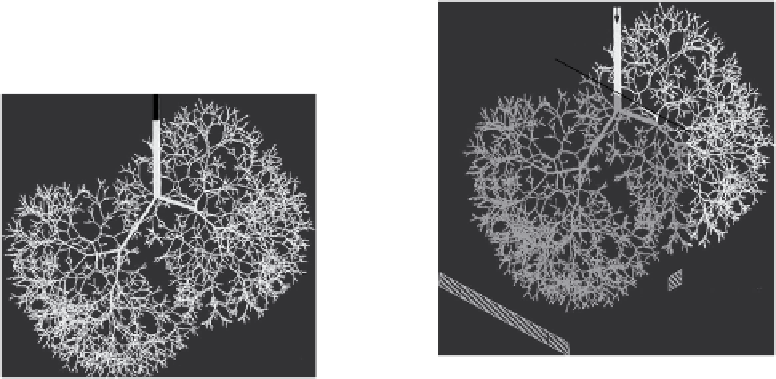Environmental Engineering Reference
In-Depth Information
representations of branching network of the human lung. The most widely used idealized model
is the symmetric model of Weibel.
91,92
In his model, the lung is characterized as a symmetric and
dichotomously branching tree of tubular airways. Idealized asymmetrical models of the airway
tree have also been developed. These include Weibel's asymmetric “B” model
92
and the models of
Horsield
93
and Horsield and Cumming.
94,95
5.4.3.2 Data-Driven Models
Other more biologically realistic morphological models also have been derived from experimen-
tally obtained morphometric data. Soong et al.
96
presented a stochastic model of the human TB
tree, using Weibel's symmetric model as the underlying average model, and incorporating prob-
ability distributions of lengths and airways based on several experimental studies (e.g., Jesseph and
Merendino
97
and Parker et al.
98
). Horsield et al.
99
developed a theoretical model of the bronchial
tree based on measurements from human casts. Kitaoka et al.
100
also presented a model of the 3D
branching structure of the lung based on morphometric studies. Their model was derived using an
algorithm guided by several morphology- or physiology-based “rules,” such as prescribed relation-
ships between airway length and diameter and between airway diameter and low rate.
5.4.3.3 Three-Dimensional Morphological Models for Interpretation of Lung Images
3D morphological models have been built for use in the interpretation of images in experimental
deposition studies. These models consist of a branching network of line segments, oriented in 3D
space via idealized or physiologically realistic branching and gravity angles. Martonen et al.
101,102
have developed models for image interpretation based on idealized branching networks. An exam-
ple of such a model is shown in Figure 5.4. More recently, Montesantos et al.
103
have developed
hybrid 3D models of branching networks for image analysis. These methods construct the irst ive
airway generations of the branching network high-resolution computed tomography data, poten-
tially allowing the network to be personalized to a particular subject within a lung deposition study.
The use of branching network models in gamma scintigraphy is discussed further in the section on
experimental deposition measurements.
5.4.3.4 Three-Dimensional Morphological Models for CFPD
With the increase in use of CFPD as a research tool, there has been a drive to develop 3D models of
respiratory system morphologies for use in CFPD studies. These models, which may be developed
Individual voxel
(A)
(B) Individual slices associated with SPECT images
FIGURE 5.4
Branching lung network model (A) and an associated network of voxels (B, not to scale) for
analysis of SPECT images of aerosol distribution.
































































Search WWH ::

Custom Search